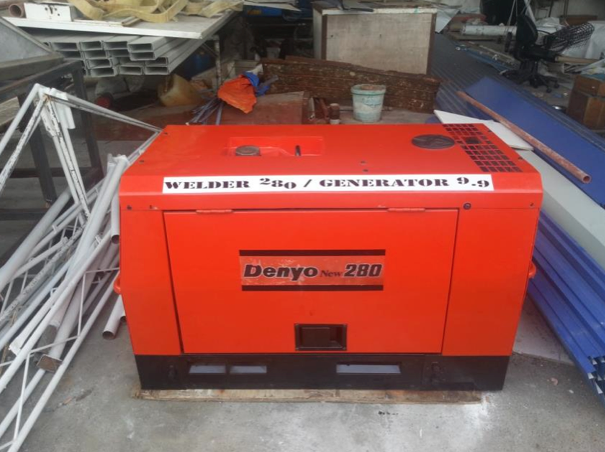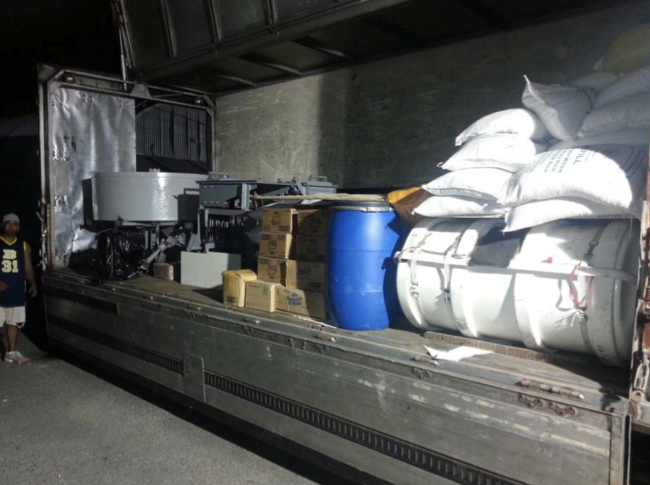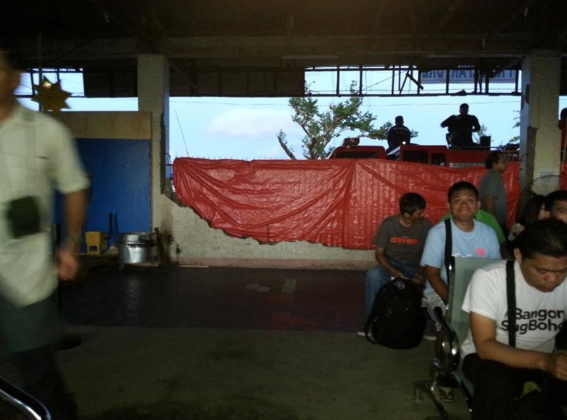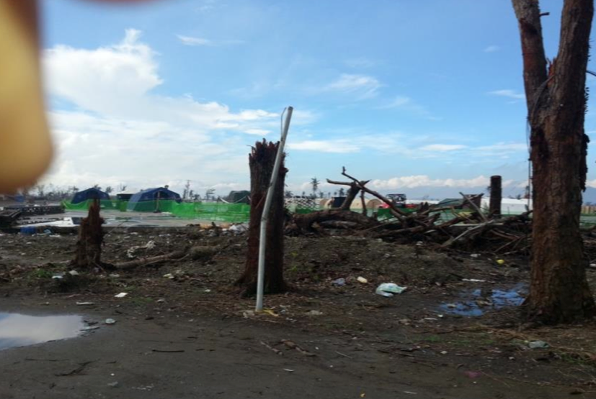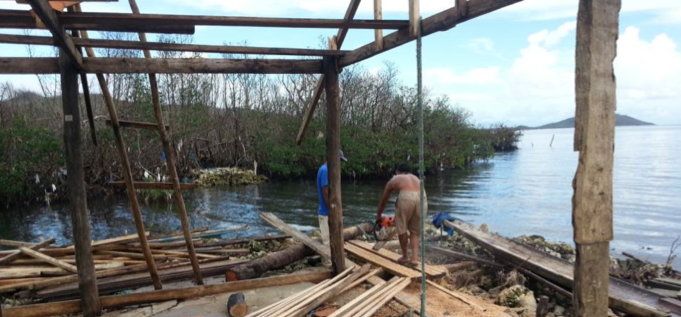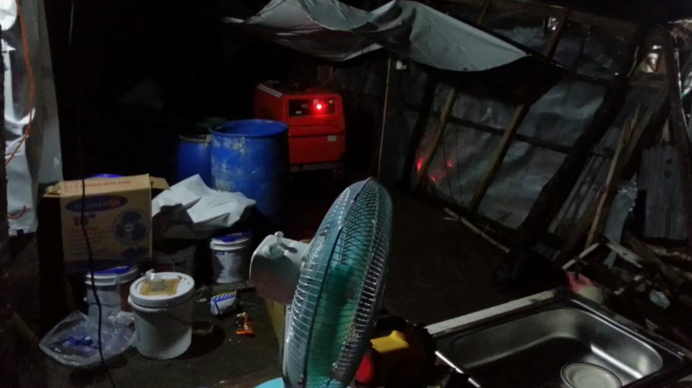Transform Relief Update: Maslog, Eastern Samar Relief by Ocean Adventure and Tim and Josie Advincula Desmond
Following is an update as of December 14, 2013 on the Maslog Relief project being spearheaded by native daughter Josie Advincula Desmond and her husband Tim Desmond, and Ocean Adventure Marine Park of Subic Bay Freeport. I want to put the report’s summary right up front: “We have raised and spent over $40,000 to date and probably another $30,000 in donated goods. I want to thank each and every one of your for your help. Our actions to date have had a huge impact on the welfare of @2500 people. If we hadn’t acted they would be in much worse shape. They still need our help. If you can find it in your hearts, help us keep this going. Again we are a private relief group focused around a particular community and extended family. No tax break and we are doing this using an extended family and close friends to deliver and control the process. We’d like to give these people something to look forward to for Christmas. We’d appreciate if you help us do that. Tim Desmond”
Josie Advincula Desmond – Ocean Adventure Maslog Relief Project Update as of 14 December
Reported by Tim Desmond
I just returned from Maslog yesterday. We delivered the 10 tons of supplies to Maslog successfully on Wednesday.
Earlier in the week we had loaded three vans with a 10-ton payload. Aside from food, clothes, and medicine, we sent Chain saws, tarps, nails, tools, two life rafts/ emergency shelters, two generators and a hollow block making machine.
Due to the large amount of goods, we rented a enclosed van that could carry 7.5 tons of payload. After we loaded it to the maximum allowable, we filled the FB300 van and still had almost a ton of water and sodas and water purification equipment. Luckily, we had our PNP neighbors who would be traveling to Samar about the same time escorting another relief mission and they agreed to take our last ton of supplies if we split the load with them. So half that load went to Maslog and half to Borongon
The convoy left on Satuday afternoon. After some flat tire trouble in Quezon province which cost them a day to repair, they made it to the Matnog ferry about midnight Monday night. They crossed to Samar and then slept until morning. Late morning Tuesday they proceeded to Paranas where they rested briefly and then proceeded to Maslog.
Loading the trucks at Ocean Adventure .
FB 300 Van ready to roll .
7.5 Ton Payload
PNP assistance taking 1 ton of water and water purification gear.
Tacloban Airport Departure Area with the walls blown out by the storm surge. .
Wilson and I flew in Wednesday morning after staying the night near the airport when our flight to Tacloban was cancelled. The airport itself was in tatters. There was no power, no water, the roof was unable to hold out the rain. The chair in the waiting room were those that had been torn from the brackets and were just sitting on the floor at a wacky slope
Transportation systems are coming back on line and we caught a fast van that took us through Tacloban, across the San Juanico Bridge and down the coast of Samar and Eastern Samar to Maslog
The drive was a sobering and absolutely unforgettable experience. The scale of the destruction is something I have never experienced. I am very familiar with Tacloban. However, for most of the drive through town I couldn’t place where I was. As the news reports have shown, the area around the airport was totally devastated. What the TV image can’t show is the scale of the destruction.
Relief agencies have been active in the area and tent cities cover the areas that have been bulldozed free of debris. Aside from the tents, little sari-sari stores made from collections of usable of debris are popping up. Life is going on although with great difficulty. It is nowhere near normal even in the heart of Tacloban. The only electricity being provided is for the street lights of Tacloban proper. All the businesses operate on generator power. Below is a shot of the immediate area outside the airport.
After passing over the bridge we drove through Basey where so many died in a flat lowland area. Most of the houses in this area were simply erased when the 20 foot wall swept through the area. There were scattered new houses made of pieces of destroyed houses and tarps. Two or three families would be jammed inside these spaces. There is no power anywhere in Samar or Eastern Samar that we saw. When we got our generator up and running it was a huge hit. There is limited fresh water in the big towns and most small towns. Luckily Maslog has a good deep well that provides adequate water for the town.
The farther we traveled into Eastern Samar the worse the wind damage became. I saw towns that I had passed many times before. Prior to Yolanda, I would just get a glimpse of them as I sped past in a van. This time I could see each town long before we arrived because all of the coconut trees that hid them were gone. They seemed naked almost We passed through miles and miles of total destruction. It was quite depressing because it made me feel that our effort was so paltry. I had to remind myself, looking at the vast scene, that we need to “think global and act local” in situations like this. Then I noticed all the people trying so hard to put their lives back together. That brought me around.
When we arrived in Maslog, things were no different. Destruction everywhere, but people were busy rebuilding with whatever was at hand. The biggest problem was that the entire town is clogged with debris. When we pulled into the town, the streets were in fact clear and the habitable houses had been cleared around them just enough to function. Everything else was just a trash heap. The areas that we wanted to use had to be cleared of a huge amount of debris just to gain access to the site.
When we started working, people came out of nowhere to help us with the scut work. After clearing debris around the skeleton of a house we set up a shed using the old slab, columns and beams of a destroyed house, bamboo poles and tarps. Luckily, there was a low hollow block wall that kept the mud and debris from infiltrating into the shed. Only half the shed had a concrete slab so we covered with entire floor with pallets made of coco lumber cut with the saws we provided. In the end, we were one of the few “houses” that was substantially dry. Inside Jo’s grandmother’s house, which is tilting crazily, only about 25% of the space is really dry. The rest is covered with tarps. It is the start of the rainy season and it is raining about half the time. It is really miserable inside these homes as they scurry around trying to put away things that were in use away when it started to rain.
Once the area was cleared and the “house” was up, we cleared a space beside the house to place the generator that would provide light to the area. Then, It was time to unload the truck. It was hard work but pretty fun as well. The mood was like a party. Somebody had some music going. Lot’s of laughing.
After unloading the truck, Wilson and his team began to set up the generator and string out the lights for the immediate area surrounding our relief station. We took a walk around the area while they were working. The following are a few shots of the area. Below, the surge blewout a second story walls on this house.
Above, Jo and her mom take in the new “open air” motif of mom’s house courtesy of Yolanda. Below Leo, a master woodsman and furniture maker who worked for us before ( he made my dining room table) cuts “1×2” nailers from coco lumber with one of our chain saws. The other saw was already in the field planking lumber for his and other homes. A beautiful, handmade two-story home stood on that site before. It was wiped clean by the surge.
Below is the kitchen used by Jo’s mom and sister. Her sister’s house, which was located behind her mother’s was lightweight wood and was erased.
One of our strategies to help rebuild over the long term is to establish a hollow block factory operated by local villagers (livelihood) and sold to contractors rebuilding the more substantial homes in the area. The revenue earned will be used to fund construction materials for rebuilding the homes (in concrete) of many of Jo’s relatives and others who can not afford a hollow block home. Wilson has placed the hollow block maker and its foundation is poured. It will to set for a couple of weeks before operations begin. He already has interested customers. He will place our skilled hollow block maker in Maslog for a couple of weeks to train locals to operate the factory.
We returned before dark and set up the camp. We cleared an area and inflated the two liferafts which were immediately used to get the remaining supplies out of the rain that couldn’t fit in the supply shed. We also moved all the personal gear for Jo, Wilson and my self out of her grandmother’s house and into the tents. The little red light above is the generator at work on its first night. The tents and the light made our site a huge attraction after dark. It was quite amusing. Other than our team, a large number of people gathered just at the edge of the light. After a while the kids started walking through the lighted area to take a peek at our stuff and the tents. It was a little like people cruising a popular street market. Fun to watch. Intense curiosity mixed with a “we’re cool” posture.
I got up at 2 a.m. and headed back to Tacloban. I did not see one light as I passed through two provinces. We had an exciting moment when our accelerator cable broke in the middle of nowhere at about 4 am in Eastern Samar, we flagged down the first vehicle and it turned out to be a van for hire on its way to manila with two seats available. We got a ride to the airport for p1000. Lucky us. This last shot is of the check-in counter for Philippine airlines in Tacloban
What Now?
After this visit it became clear that we need to continue the food aid. There is only one shipment a week arriving in Lawaan from a local source who is passing along Caritas Aid sacks. Quite clearly, there is a heavy “friction” cost from local politicians, when it comes to passing along aid from relief agencies. As we suspected Maslog is far down the food chain. Some tents and tarp materials have arrived in sufficient quantities to eliminate the need for us to provide more. The nails and hand tools are in great demand. Fuel to power the generators and provide light at night is a must. Power will not be restored for some time and when it is, only the basic main power will be restored. The neighborhood needs to be completely rewired for power. It will be several months before the generator will not be needed anymore for lighting. That means we need fuel for lighting for 6 hours a night. The big generator will use about 2.5 liters of fuel per night. The little one is half that. The vehicles will be making runs to collect materials and fuel. Fuel will be the major operating cost.
There is better news on the transportation front. With our vehicles in place in Maslog now. We don’t need to send large trucks any more. We can send food and supplies as cargo on commercial buses and we can pick it up at the bus stop with our van. Things like rice, other foods and nails can be sent in this way.
Security is much improved. There is no further need to provide security on the roads because we won’t send trucks. We just need security on the storage shed, generator and the hollow block factory. Once the hollow block factory starts operating the employees will sleep there and secure it.
People have been planting crops and more locally grown food should become progressively more available in the next several weeks
We would like to assemble gifts for the kids and distribute them before Christmas.
In kind donations:
Rice
Noodles
Canned goods
Soap hand and laundry
Nails (large boxes)
Clothes
Toys
Zip Lock Bags
Towels
Our budget for the next two months has been amended after the visit to look like this. It will develop further when Wilson returns.
- Fuel needs: p100,000/month for two months
- Hollow Block plant start up p 50k
- Shipping fees p25,000 (bus)
- Security Services: p30,000/month for two months
- Jo’s operating team budget – p25,000 for two months (food, vehicle repair, etc)
- Food Supplementation:
- Rice 120k (3 tons)
- Canned goods 60k (4,000 cans)
- Misc Dry goods – 50k
- Medical supplies 150k – 50% of initial purchase
- Clothes (Donations)
- Construction materials 100k (nails, etc.)
- Christmas gifts for the kids (donations)
What we need to accomplish this is @850k plus cash donations to buy toys to maintain. A 100 peso toy for 500 kids is p50,000.
All in we need @900,000 from this point forward to maintain what I have laid out. That is a little over $US20,000.
We have raised and spent over $40,000 to date and probably another $30,000 in donated goods. I want to thank each and every one of your for your help. Our actions to date have had a huge impact on the welfare of @2500 people. If we hadn’t acted they would be in much worse shape. They still need our help. If you can find it in your hearts, help us keep this going. Again we are a private relief group focused around a particular community and extended family. No tax break and we are doing this using an extended family and close friends to deliver and control the process. We’d like to give these people something to look forward to for Christmas. We’d appreciate if you help us do that.
Thanks,
Tim Desmond
Send your donations to:
Please wire US dollars to:
Account name: Josephine A. Desmond
Account #: 8333015413
Rizal Commercial Bank Corp.,
Subic Bay Freeport Branch
ROYAL SUBIC DUTY FREE COMPLEX COR RIZAL & ARGONAUT
Subic Bay Freeport Zone
Philippines 2222
SWIFT CODE: RCBCPHMMXXX
For online money donations only:
https://rally.org/philippinetyphoonrelief
For local donations including bank deposit info and food, supplies, etc:
http://www.oceanadventure.com.ph/typhoon-help-program
Year of the Spy Book Trailer
Above is the Year of the Spy Book Trailer — for my upcoming non-fiction book about espionage upheavals on the streets of Moscow in 1985.
Below is a “trailer” showcasing the writing and video services I provide to clients.
Michael Sellers — Writing and Video Services
My eBook — Just released Dec 5, 2012
EBook You don't need a Kindle or iPad -- Download Adobe Digital Editions for Free, then read the .mobi (Kindle Format) or .epub (Nook, iPad Format) digital book on your computer. Or order the PDF which is formatted exactly like the print book.Recent Posts
- Arsha Sellers — Today I’m One Big Step Closer to Becoming a Real Forever Dad
- Meet Abby Sellers and Arshavin Sellers — My Wife, My Son, My Inspiration Every Day
- What the Mueller Report Actually Says
- Remembering James Blount, an American Who “Got” the Philippines in 1901
- America the Beautiful? You Mean America the Pitiful. I Am Ashamed


